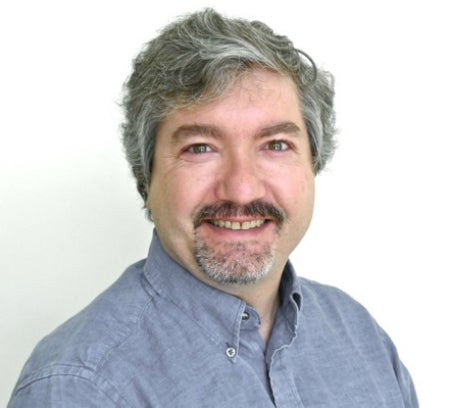Physics Professor Publishes Paper on Graphene Research
 May 12, 2015—Professor of Physics Jim Freericks’ paper, “Theory of Floquet band formation and local pseudospin textures in pump-probe photoemission of graphene,” was recently accepted for publication by the open access journal Nature Communications. The paper explores the process of using lasers to control energy bands in graphene, an emerging material that could influence the way electronics are made.
May 12, 2015—Professor of Physics Jim Freericks’ paper, “Theory of Floquet band formation and local pseudospin textures in pump-probe photoemission of graphene,” was recently accepted for publication by the open access journal Nature Communications. The paper explores the process of using lasers to control energy bands in graphene, an emerging material that could influence the way electronics are made.
Graphene has been called the thinnest and strongest substance known to science—one million times thinner than paper. It’s an allotrope of carbon, meaning it is a structurally different form of the element, where the same atoms bond together in different ways. Graphene comprises a single layer of carbon atoms that are bonded together in a repeating pattern of hexagons. In 2010, two physicists at the University of Manchester won the Nobel Prize in Physics for their pioneering research on graphene.
Freericks’ research focuses on how graphene’s electronic properties can be quickly modified—in a millionth of a billionth of a second, or a femtosecond—by using a laser.
“[The project demonstrates] how one can control the way electrons move through a material at an extremely fast timescale—almost one million times faster than a current computer processor—by shining light on it,” Freericks explained.
Freericks and his collaborators used large-scale numerical simulations to predict how lasers can modify the properties of graphene (which are single-atom-thick sheets of carbon). Their findings may help scientists tune and control material properties with optical laser pulses, which could lead to new developments in electronics.
“This work has the potential to usher in a new era of designs for the extremely fast electronics of the future,” Freericks said. “I hope that this will lead…to even more advances that will greatly increase the speed of our computers by invoking novel design strategies and ultrafast switching.”
Freericks’ collaborators include Michael Sentef, Martin Claassen, Alexander Kemper, Brian Moritz, and Takashi Oka. The project was supported by the Department of Energy and Georgetown’s Robert L. McDevitt bequest.
Related Information
Freericks’ study was highlighted by SLAC National Accelerator Laboratory, a multi-program laboratory exploring questions in photon science, astrophysics, particle physics, and accelerator research. SLAC is operated by Stanford University for the Department of Energy’s Office of Science. SLAC featured Freericks’ research on May 27, 2015. “The results [of the study]…pave the way for experiments that create and control new states of matter with this specialized form of light, with potential applications in computing and other areas,” the organization wrote.